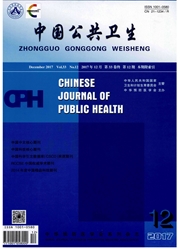

 中文摘要:
中文摘要:
目的了解蒙古族农牧区居民代谢综合征(MS)患病率及其危险因素。方法选择内蒙古通辽市半农半牧地区≥20岁的常住蒙古族居民共2 589人作为研究对象。采用现况研究方法,用统一设计的调查表,对研究对象进行面对面问卷调查;采集血液标本;测量身高、体重、腰围、臀围及血压值等指标。测定血糖、血脂及C反应蛋白(CRP)等生化指标。结果共获得2 536人完整的生化指标。MS粗患病率为20.9%,其中男性为12.9%,明显低于女性的26.4%(χ^2=67.85,P〈0.001);MS标化患病率为17.1%,其中男性为11.4%,女性为21.6%(χ^2=44.86,P〈0.001)。MS各组分中,肥胖、血压升高、高甘油三酯(TG)、高密度脂蛋白(HDL)偏低及血糖升高的患病率分别为36.0%,50.7%,17.5%,54.0%及22.2%。单因素分析结果显示,年龄、性别、吸烟、饮酒、高血压家族史、高胆固醇(TC)、低密度脂蛋白(LDL)、载脂蛋白B100(apoB)、CRP、臀围、腰臀比及体质指数(BMI)等12个因素为蒙古族农牧民MS的危险因素(P〈0.05)。调整混杂因素后,年龄、性别、LDL、CRP、臀围、腰臀比及BMI等7个因素对蒙古族农牧民MS的影响差异仍有统计学意义(P〈0.05)。结论通辽市蒙古族农牧民MS患病率较高,女性MS患病率高于男性;年龄、性别、LDL、CRP、臀围、腰臀比及BMI这7个因素是蒙古族农牧民MS的独立危险因素。
 英文摘要:
英文摘要:
Objective To investigate the prevalence of metabolic syndrome and its risk factors among Mongolian people in Tongliao city. Methods A total of 2 589 Mongolian people aged 20 and eider from agricultural and pastoral areas in Tongliao City of Inner Mongolia were included in this study. A cross - sectional survey was conducted to collect data by pereonal interview using a standard questionnaire. Height, weight, waist circumference, hip circumference, blood pressure, fasting plasma glucose, blood fat and CRP were measured. Results 2 536 people completed all biochemical examination. The crude prevalence of metabolic syndrome(MS) was 20.9 %, and women had a higher prevalence of MS than men(women 26.4%, men 12.9 %, x^2 = 67.85, P 〈 0. 001 ). The agestandardized prevalence of the MS was 17.1%, and compared with men, women had a higher prevalence of MS ( woman 21.6 %, man 11.4 %, x^2 = 44.86, P 〈 0. 001 ). The prevalence of obesity, raised blood pressure, raised triglycerides, reduced HDL - cholesterol, and raised fasting glucose was 36.0 %, 50.7 %, 17.5 %, 54.0 % and 22.2 %, respectively. The result of univariable Logistic regression showed that age, female, smoking, drinking, family hypertension history, TC, LDL - C, apoB, CRP, hip circumference, waist - hip ratio and BMI index were risk factors of MS in the subjects(P 〈 0.05). After controlling for confounding factors, age, female, LDL- C, CRP, hip circumference, waist - hip ratio and BMI index were risk factors of the MS( P 〈 0.05). Conclusion The prevalence of metabolic syndrome in local Mongolian people was high, and compared with men, women had a higher prevalence of MS. After controlling for confounding factors, age, female, LDL - C, CRP, hip circumference, waist - hip ratio and BMI index were independent risk factors of the MS among Mongolian people in agricultural and pastoral areas.
 同期刊论文项目
同期刊论文项目
 同项目期刊论文
同项目期刊论文
 期刊信息
期刊信息
